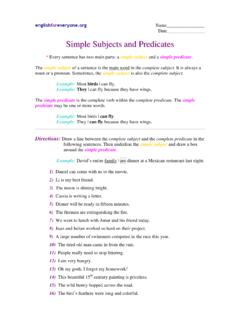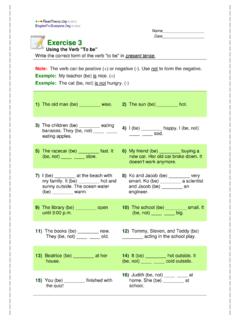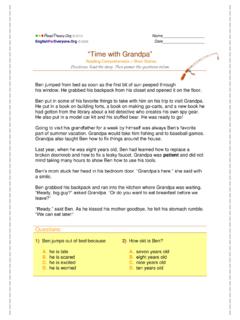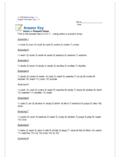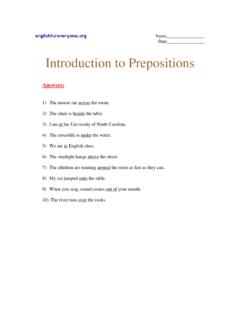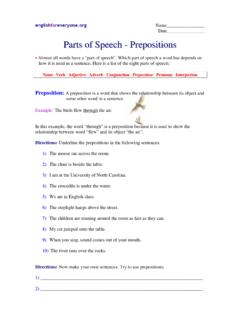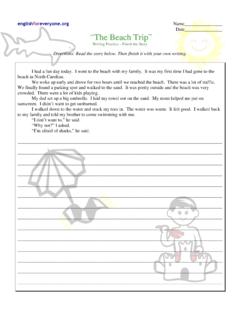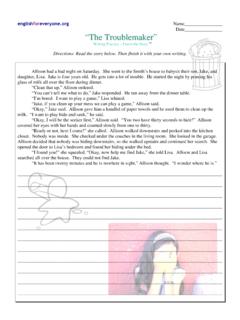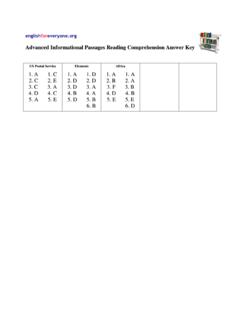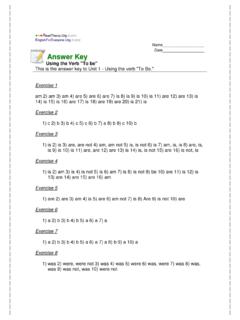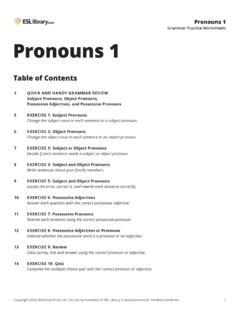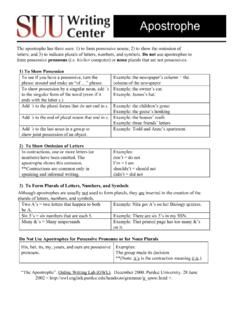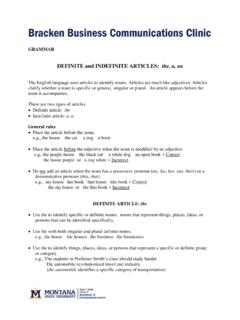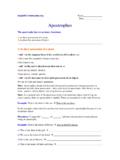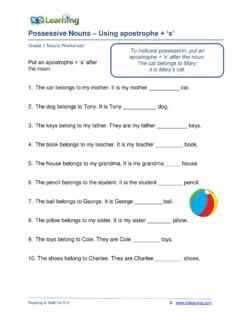Transcription of Possessive Pronouns - EnglishForEveryone.org
1 Name_____ Date_____ Possessive Pronouns A pronoun is a word that is used to take the place of a noun . They make sentences shorter and easier to say. A Possessive pronoun is a word that takes the place of names of someone or something and shows possession. Possessive Pronouns (all besides for one s) do not require apostrophes. Here is a list of Possessive Pronouns : Note: In this exercise, what are sometimes referred to as Possessive Adjectives fall under the general heading Possessive Pronouns for simplicity. Read the conversations below to get an idea about how Possessive Pronouns are used: Albert: Is this my cup of water?
2 Linda: No, I don t think so. Albert: Whose is it then? Linda: I think it is theirs. Albert: Oh, where is mine then? Linda: Yours is over there. Albert: Oh, okay. Jaime: Here is a picture of my girlfriend. Pria: Oh that is nice. Where did you take her picture? Jamie: I took it at Duke Forest. That is our favorite place. Pria: Do they have nice trees in Duke Forest? Jamie: Yes, their trees are very nice. My: The pronoun my is used to describe something that belongs to me.
3 My must be followed by the noun possessed. Example: These are my rings. In this example, the pronoun my shows that the rings belong to me. Directions: try to make your own sentences using the pronoun my . 1) _____ 2) _____ Mine: The pronoun mine is used to describe something that belongs to me. Mine takes the place of the noun it possesses. Therefore, it is never followed by a noun . Example: The keys are mine. In this example, the pronoun mine shows that the keys belong to me. Directions: try to make your own sentences using the pronoun mine . 1) _____ 2) _____ Our: The pronoun our is used to describe something that belongs to us.
4 Our must be followed by the noun possessed. Example: Our house is white. In this example, the pronoun Our shows that the house belong to us. Directions: try to make your own sentences using the pronoun our . 1) _____ 2) _____ Ours: The pronoun ours is used to describe something that belongs to us. Ours takes the place of the noun it possesses. Therefore, it is never followed by a noun . Example: The money is ours. In this example, the pronoun ours shows that the money belongs to us. Directions: try to make your own sentences using the pronoun ours . 1) _____ 2) _____ Your: The pronoun your is used to describe something that belongs to you.
5 Your must be followed by the noun possessed. Example: This is your shoe. In this example, the pronoun your shows that the shoe belong to you. Directions: try to make your own sentences using the pronoun your . 1) _____ 2) _____ Yours: The pronoun yours is used to describe something that belongs to us. Yours takes the place of the noun it possesses. Therefore, it is never followed by a noun . Example: The car is yours. In this example, the pronoun yours shows that the car belongs to you. Directions: try to make your own sentences using the pronoun yours . 1) _____ 2) _____ His: The pronoun his is used to describe something that belongs to a male.
6 His may take the place of the noun it possesses, or it may not. Example: That pencil is his. In this example, the pronoun his shows that the pencil belongs to him. Directions: try to make your own sentences using the pronoun his . 1) _____ 2) _____ Her: The pronoun her is used to describe something that belongs to a female. Her must be followed by the noun possessed. Example: Her hair is brown. In this example, the pronoun Her shows that the hair belong to a female. Directions: try to make your own sentences using the pronoun her . 1) _____ 2) _____ Hers: The pronoun hers is used to describe something that belongs to a female.
7 Hers takes the place of the noun it possesses. Therefore, it is never followed by a noun . Example: This pen is hers. In this example, the pronoun hers shows that the pen belongs to a female. Directions: try to make your own sentences using the pronoun hers . 3) _____ 4) _____ Its: The pronoun its is used to describe something that belongs to it. Its must be followed by the noun possessed. Example: Here is its arm. In this example, the pronoun its shows that the arm belongs to it. Directions: try to make your own sentences using the pronoun its . 1) _____ 2) _____ Their: The pronoun their is used to describe something that belongs to them.
8 Their must be followed by the noun possessed. Example: Where are their tickets? In this example, the pronoun their shows that the tickets belong to them. Directions: try to make your own sentences using the pronoun their . 1) _____ 2) _____ Theirs: The pronoun theirs is used to describe something that belongs to them. Theirs takes the place of the noun it possesses. Therefore, it is never followed by a noun . Example: The cats are theirs. In this example, the pronoun theirs shows that the cats belong to them. Directions: try to make your own sentences using the pronoun theirs . 1) _____ 2) _____ Whose: The pronoun whose is used to describe something that belongs to an unknown.
9 Whose must be followed by the noun possessed. Example: Do you know whose dictionary this is? In this example, the pronoun whose shows that the dictionary belong to an unknown. Directions: try to make your own sentences using the pronoun whose . 1) _____ 2) _____ One s: The pronoun one s is used to describe something that belongs to a universal individual. One s must be followed by the noun possessed. Example: It is a good idea to save one s money. In this example, the pronoun one s shows that the money belongs to a universal individual. Directions: try to make your own sentences using the pronoun one s.
10 1) _____ 2) _____ Directions: now try to use what you have learned about Possessive Pronouns to fill in the empty spaces below. This weekend I am going to the beach. I am not sure which car I should take. I could take ____ mother s car but I am not sure if _____ is running properly. I think I will take ____ father s car because _____ is new and is running well. I definitely cannot take _____ because I crashed it last week when I was driving too fast. I also need to take some sun block with me. I don t have time to buy some myself, so I guess I will ask ___ neighbors if I can borrow _____. I could use the sun block that I found at school but I am scared to use it because I don t know _____ it used to be.
